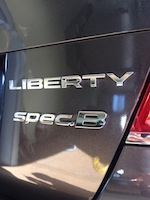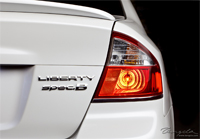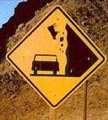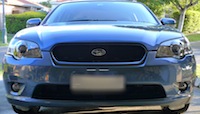Hi guys,
I have just purchased F&R Cusco sway bars (non adjustable I think) plus HD mounts..
Now my question is, what's the difference between adjustable and non adjustable.. What is it that is adjustable and what are the advantages of the adjustable one over the non adjust...
This is to be on a 08 GTB for a daily driver..
Thanks guys
Sway bar Q
21 posts
• Page 1 of 2 • 1, 2
Sway bar Q
Mods on the car already
3" Xforce TBE, Iridum spark plugs, MSR Tune (191KWatw), Alpine Dub Din HU with inbuilt sat nav & bluetooth etc, top of the line memphis speakers including a memphis mojo amp to run it all, Optima Yellow top battery to juice it, TMIC from Jacks-GTB, bigger fuel pump also from Jacks-GTB, Spec.B Badge, Rota Gravels, Brembo brakes, 5% tint all round, currently working on an engine rebuild, NEW STI Shrt Block, forged pistons, bigger head studs and all work done by MSR, Cobb Intake
Mods to come
Un= Headers, Blouche Turbo, MSR Tune, Ohlin Coilys, Whiteline suspension, detail with Opticoat
TBC...
It Is What It Is
3" Xforce TBE, Iridum spark plugs, MSR Tune (191KWatw), Alpine Dub Din HU with inbuilt sat nav & bluetooth etc, top of the line memphis speakers including a memphis mojo amp to run it all, Optima Yellow top battery to juice it, TMIC from Jacks-GTB, bigger fuel pump also from Jacks-GTB, Spec.B Badge, Rota Gravels, Brembo brakes, 5% tint all round, currently working on an engine rebuild, NEW STI Shrt Block, forged pistons, bigger head studs and all work done by MSR, Cobb Intake
Mods to come
Un= Headers, Blouche Turbo, MSR Tune, Ohlin Coilys, Whiteline suspension, detail with Opticoat
TBC...
It Is What It Is
-

LBR37Y - formerly LBR37Y
- Posts: 448
- Joined: Sat May 26, 2012 6:41 pm
- Location: Morisset, Central Coast NSW
- Car: Mitsubishi Triton GLX-R 2010
- Real name: Nick
Re: Sway bar Q
Adjustable is for Whiteline bars.
Benefit is....you can change the bars stiffness because it has 2 slots on each side of the bar, so you can choose the furthest slot for less rigidity, or closer in for more.
As someone who doesn't track the car, an "adjustable" bar is useless to me. Why on earth anyone would want an adjustable bar I don't know, but I'm sure there is a reason to some people, although I personally can't see one.
Cusco sways are not adjustable, it has one setting and that is all that you need.
Benefit is....you can change the bars stiffness because it has 2 slots on each side of the bar, so you can choose the furthest slot for less rigidity, or closer in for more.
As someone who doesn't track the car, an "adjustable" bar is useless to me. Why on earth anyone would want an adjustable bar I don't know, but I'm sure there is a reason to some people, although I personally can't see one.
Cusco sways are not adjustable, it has one setting and that is all that you need.
-

Kekotic - -stickered-
- Posts: 6452
- Joined: Tue Jun 08, 2010 6:46 pm
- Car: MY07 Liberty GT Spec.B
- Profile URL: viewtopic.php?f=10&t=13066
Re: Sway bar Q
Ok seems legit it me..
Thanks mate!!
Thanks mate!!
Mods on the car already
3" Xforce TBE, Iridum spark plugs, MSR Tune (191KWatw), Alpine Dub Din HU with inbuilt sat nav & bluetooth etc, top of the line memphis speakers including a memphis mojo amp to run it all, Optima Yellow top battery to juice it, TMIC from Jacks-GTB, bigger fuel pump also from Jacks-GTB, Spec.B Badge, Rota Gravels, Brembo brakes, 5% tint all round, currently working on an engine rebuild, NEW STI Shrt Block, forged pistons, bigger head studs and all work done by MSR, Cobb Intake
Mods to come
Un= Headers, Blouche Turbo, MSR Tune, Ohlin Coilys, Whiteline suspension, detail with Opticoat
TBC...
It Is What It Is
3" Xforce TBE, Iridum spark plugs, MSR Tune (191KWatw), Alpine Dub Din HU with inbuilt sat nav & bluetooth etc, top of the line memphis speakers including a memphis mojo amp to run it all, Optima Yellow top battery to juice it, TMIC from Jacks-GTB, bigger fuel pump also from Jacks-GTB, Spec.B Badge, Rota Gravels, Brembo brakes, 5% tint all round, currently working on an engine rebuild, NEW STI Shrt Block, forged pistons, bigger head studs and all work done by MSR, Cobb Intake
Mods to come
Un= Headers, Blouche Turbo, MSR Tune, Ohlin Coilys, Whiteline suspension, detail with Opticoat
TBC...
It Is What It Is
-

LBR37Y - formerly LBR37Y
- Posts: 448
- Joined: Sat May 26, 2012 6:41 pm
- Location: Morisset, Central Coast NSW
- Car: Mitsubishi Triton GLX-R 2010
- Real name: Nick
Re: Sway bar Q
chaotic2050 wrote:Adjustable is for Whiteline bars.
Benefit is....you can change the bars stiffness because it has 2 slots on each side of the bar, so you can choose the furthest slot for less rigidity, or closer in for more.
As someone who doesn't track the car, an "adjustable" bar is useless to me. Why on earth anyone would want an adjustable bar I don't know, but I'm sure there is a reason to some people, although I personally can't see one.
Cusco sways are not adjustable, it has one setting and that is all that you need.
Whiteline is one manufacturer of adustable bars, but not the only one.
Adjustable bars aren't something you'd generally adjust regularly - they do give you more flexibility (wrong word in this context perhaps! :p) in terms of what you get for your money.
If you buy a 22mm fixed bar for example, you're stuck with the setting as it comes from the factory. It might suit you perfectly - in which case, well done. But an adjustable bar gives two settings that you can choose from. You might buy a 21mm adjustable bar, and on the loosest setting, it may behave more like a 19mm non-adjustable bar. On the tighest setting, it may behave more like a 23mm non-adjustable bar. So you get a bit of "play" in how you set the car up to suit your requirements. And some adjustable bars have three settings - the middle one is roughly the equivelent of the same thickness non-adjustable bar, and then you have one setting which is stiffer, and one setting on the other side which is not quite as stiff.
Also be aware that just because a bar has a given thickness (let's say 22mm), not all bars of that same thickness will behave in exactly the same way. A 22mm bar from one manufacturer may be harder than the 22mm bar from another. The material used, the profile of the material (solid, hollow, if hollow, how thick are the walls of the tube and what shape is the tube) all have an impact - the shape of a solid bar can have an impact too (if it's not a uniform shape, it will be stronger in one direction of flex over another - a flat bar is strong in one direction (side to side along the width of the bar), but weaker up and down.
- Manaz
- Posts: 1684
- Joined: Sat May 26, 2007 2:45 pm
- Location: Sydney, Australia
- Car: MY09 Liberty GT Spec.B
- Real name: Robert
- Profile URL: viewtopic.php?f=10&t=22465
Re: Sway bar Q
Rather than start up a new thread, I got a question re: whiteline adjustable sways, and fitting them. Which hole do u fit them at to give u the firmest setting? Ive been told to fit the bars as close to the floor pan as possible to receive the hardest setting. Therefore fixing the bar in the lower hole. Does this sound right?
Edit: Dont worry I found the answer:
Edit: Dont worry I found the answer:
KiDo_Tuning wrote:One closest to the end of the bar is 'soft' and one closest to bar curve is hard as there is less 'flex' allowed
Cheers
Shav
MY07 Subaru Liberty GT Premium Sedan | HKS Panel filter | Pierburg 3 port | Whiteline adj sways F&R | Cusco HD mounts | Whiteline HD front sway links | Anycarlink AL-1080B | Ultrex s/s 3" CBE | Ultrex PU lip spoiler | Invidia s/s dump pipe and 100cel cat | KiDo tuned | DBA T2 rotors | Intima SS brake pads | Mishimoto TMIC | Koya ISR7 wheels | 265L Kobe fuel pump | Diamond Works SI Drive dial | Bilsteins
COSMETIC MODS ON THE WAY
My other toys:
2012 Focus Cayo 2.0 road bike
2015 Cervelo S5 VWD road bike
Shav
MY07 Subaru Liberty GT Premium Sedan | HKS Panel filter | Pierburg 3 port | Whiteline adj sways F&R | Cusco HD mounts | Whiteline HD front sway links | Anycarlink AL-1080B | Ultrex s/s 3" CBE | Ultrex PU lip spoiler | Invidia s/s dump pipe and 100cel cat | KiDo tuned | DBA T2 rotors | Intima SS brake pads | Mishimoto TMIC | Koya ISR7 wheels | 265L Kobe fuel pump | Diamond Works SI Drive dial | Bilsteins
COSMETIC MODS ON THE WAY
My other toys:
2012 Focus Cayo 2.0 road bike
2015 Cervelo S5 VWD road bike
-

shav - Posts: 3609
- Joined: Tue Jun 26, 2012 12:01 pm
- Location: Adelaide, Southern Suburbs
- Car: MY07 Subaru Liberty GT Premium
- Real name: Shav
- Profile URL: viewtopic.php?f=10&t=18915&start=480
Re: Sway bar Q
the hole closest to where the swaybar mounts to chassis as it makes the swaybar arm shorter = stiffer(less metal to flex).
.. Dave
-

vaccine - Posts: 212
- Joined: Mon Apr 27, 2009 6:51 am
- Location: Canberra
- Car: MY05 3RB
- Real name: dave..
Re: Sway bar Q
vaccine wrote:the hole closest to where the swaybar mounts to chassis as it makes the swaybar arm shorter = stiffer(less metal to flex).
Thanks Dave. I got it done by the mechanic in the end. Feels tighter in corners but I still need to check where he mounted the bars as confirmation.
Cheers
Shav
MY07 Subaru Liberty GT Premium Sedan | HKS Panel filter | Pierburg 3 port | Whiteline adj sways F&R | Cusco HD mounts | Whiteline HD front sway links | Anycarlink AL-1080B | Ultrex s/s 3" CBE | Ultrex PU lip spoiler | Invidia s/s dump pipe and 100cel cat | KiDo tuned | DBA T2 rotors | Intima SS brake pads | Mishimoto TMIC | Koya ISR7 wheels | 265L Kobe fuel pump | Diamond Works SI Drive dial | Bilsteins
COSMETIC MODS ON THE WAY
My other toys:
2012 Focus Cayo 2.0 road bike
2015 Cervelo S5 VWD road bike
Shav
MY07 Subaru Liberty GT Premium Sedan | HKS Panel filter | Pierburg 3 port | Whiteline adj sways F&R | Cusco HD mounts | Whiteline HD front sway links | Anycarlink AL-1080B | Ultrex s/s 3" CBE | Ultrex PU lip spoiler | Invidia s/s dump pipe and 100cel cat | KiDo tuned | DBA T2 rotors | Intima SS brake pads | Mishimoto TMIC | Koya ISR7 wheels | 265L Kobe fuel pump | Diamond Works SI Drive dial | Bilsteins
COSMETIC MODS ON THE WAY
My other toys:
2012 Focus Cayo 2.0 road bike
2015 Cervelo S5 VWD road bike
-

shav - Posts: 3609
- Joined: Tue Jun 26, 2012 12:01 pm
- Location: Adelaide, Southern Suburbs
- Car: MY07 Subaru Liberty GT Premium
- Real name: Shav
- Profile URL: viewtopic.php?f=10&t=18915&start=480
Re: Sway bar Q
Hey guys, I have a technical question,
Ive had my sway in for quite some time now. With the stock OEM springs, the sways can only do so much on the stiffest setting for both front and rear.
Im about to fit some moderately stiffer springs (Tein S-Tech) next week and was wondering if I should perhaps make an adjustment in my sway bars to compensate for anything.
Currently under the setup I have now, I get some understeer when I push it hard and some body roll. I want to get rid of that as much as possible. I assume that originally having both front and rear sways on hardest setting is doing that when I should have had the front on the softer setting? (i.e. I should've introduced a little more oversteer)
With stiffer springs about to be fitted, should I still adjust the front bar to its softer setting and let the springs take care of the body roll? Will the stiffer springs help reduce the oversteer I currently have?
Your advice is greatly appreciated.
Ive had my sway in for quite some time now. With the stock OEM springs, the sways can only do so much on the stiffest setting for both front and rear.
Im about to fit some moderately stiffer springs (Tein S-Tech) next week and was wondering if I should perhaps make an adjustment in my sway bars to compensate for anything.
Currently under the setup I have now, I get some understeer when I push it hard and some body roll. I want to get rid of that as much as possible. I assume that originally having both front and rear sways on hardest setting is doing that when I should have had the front on the softer setting? (i.e. I should've introduced a little more oversteer)
With stiffer springs about to be fitted, should I still adjust the front bar to its softer setting and let the springs take care of the body roll? Will the stiffer springs help reduce the oversteer I currently have?
Your advice is greatly appreciated.
Cheers
Shav
MY07 Subaru Liberty GT Premium Sedan | HKS Panel filter | Pierburg 3 port | Whiteline adj sways F&R | Cusco HD mounts | Whiteline HD front sway links | Anycarlink AL-1080B | Ultrex s/s 3" CBE | Ultrex PU lip spoiler | Invidia s/s dump pipe and 100cel cat | KiDo tuned | DBA T2 rotors | Intima SS brake pads | Mishimoto TMIC | Koya ISR7 wheels | 265L Kobe fuel pump | Diamond Works SI Drive dial | Bilsteins
COSMETIC MODS ON THE WAY
My other toys:
2012 Focus Cayo 2.0 road bike
2015 Cervelo S5 VWD road bike
Shav
MY07 Subaru Liberty GT Premium Sedan | HKS Panel filter | Pierburg 3 port | Whiteline adj sways F&R | Cusco HD mounts | Whiteline HD front sway links | Anycarlink AL-1080B | Ultrex s/s 3" CBE | Ultrex PU lip spoiler | Invidia s/s dump pipe and 100cel cat | KiDo tuned | DBA T2 rotors | Intima SS brake pads | Mishimoto TMIC | Koya ISR7 wheels | 265L Kobe fuel pump | Diamond Works SI Drive dial | Bilsteins
COSMETIC MODS ON THE WAY
My other toys:
2012 Focus Cayo 2.0 road bike
2015 Cervelo S5 VWD road bike
-

shav - Posts: 3609
- Joined: Tue Jun 26, 2012 12:01 pm
- Location: Adelaide, Southern Suburbs
- Car: MY07 Subaru Liberty GT Premium
- Real name: Shav
- Profile URL: viewtopic.php?f=10&t=18915&start=480
Re: Sway bar Q
I'm a suspension novice, but I would have thought that a softer rear sway bar setting will give more oversteer (in comparison) if the front bar setting is not changed? Something else to keep in mind is that if you're lowering the car with the new springs the geometry (camber/castor etc) may be affected which could complicate any seat of the pants testing. I'll zip it now and let the experts give you some proper advice.
cheers, David
MY04 2.5i Wagon | DBA T2 rotors | Bendix pads | Bilsteins | OEM Sports Grille | Custom hail damage
MY04 2.5i Wagon | DBA T2 rotors | Bendix pads | Bilsteins | OEM Sports Grille | Custom hail damage
-

notmyrealname - Posts: 81
- Joined: Sat Jan 03, 2015 11:16 pm
- Location: Brisbane
- Car: 2004 2.5i wagon
- Real name: David
Re: Sway bar Q
As a general rule of thumb; stiffer springs=softer bars. The springs/dampers will control body roll. Ultimately, you don't want sway bars as they connect the control arms together therefore reducing the suspensions ability to act independently on each side of the vehicle. Many rally cars don't run sway bars for this exact reason and use spring rates and damping to control weight shift/traction. Sway bars allow car manufactures to reach a compromise between comfort and handling allowing them to use softer springs while reducing body roll for passenger comfort. Comfort sells road cars to the masses not cornering ability.
- Adrian2627
- Posts: 1056
- Joined: Mon Jan 07, 2008 6:11 pm
- Location: Gold Coast
- Car: BP5F (MY09) Legacy 2.0 GT Spec B
- Real name: Adrian
Re: Sway bar Q
So are you saying that once the springs are in im better off backing off the stiffness in the sways to let the springs do there job?
Cheers
Shav
MY07 Subaru Liberty GT Premium Sedan | HKS Panel filter | Pierburg 3 port | Whiteline adj sways F&R | Cusco HD mounts | Whiteline HD front sway links | Anycarlink AL-1080B | Ultrex s/s 3" CBE | Ultrex PU lip spoiler | Invidia s/s dump pipe and 100cel cat | KiDo tuned | DBA T2 rotors | Intima SS brake pads | Mishimoto TMIC | Koya ISR7 wheels | 265L Kobe fuel pump | Diamond Works SI Drive dial | Bilsteins
COSMETIC MODS ON THE WAY
My other toys:
2012 Focus Cayo 2.0 road bike
2015 Cervelo S5 VWD road bike
Shav
MY07 Subaru Liberty GT Premium Sedan | HKS Panel filter | Pierburg 3 port | Whiteline adj sways F&R | Cusco HD mounts | Whiteline HD front sway links | Anycarlink AL-1080B | Ultrex s/s 3" CBE | Ultrex PU lip spoiler | Invidia s/s dump pipe and 100cel cat | KiDo tuned | DBA T2 rotors | Intima SS brake pads | Mishimoto TMIC | Koya ISR7 wheels | 265L Kobe fuel pump | Diamond Works SI Drive dial | Bilsteins
COSMETIC MODS ON THE WAY
My other toys:
2012 Focus Cayo 2.0 road bike
2015 Cervelo S5 VWD road bike
-

shav - Posts: 3609
- Joined: Tue Jun 26, 2012 12:01 pm
- Location: Adelaide, Southern Suburbs
- Car: MY07 Subaru Liberty GT Premium
- Real name: Shav
- Profile URL: viewtopic.php?f=10&t=18915&start=480
Re: Sway bar Q
To start with yes. It will depend on the springs and sway bars you are using as to what will achieve your desired results. You might even find you will go back to the stock bars.
- Adrian2627
- Posts: 1056
- Joined: Mon Jan 07, 2008 6:11 pm
- Location: Gold Coast
- Car: BP5F (MY09) Legacy 2.0 GT Spec B
- Real name: Adrian
Re: Sway bar Q
Adrian2627 wrote:To start with yes. It will depend on the springs and sway bars you are using as to what will achieve your desired results. You might even find you will go back to the stock bars.
Im using full adjustable sway from whiteline. Tein S-tech springs.
I'll get the sways adjusted to full soft once the springs go in and gauge it from there.
Cheers
Shav
MY07 Subaru Liberty GT Premium Sedan | HKS Panel filter | Pierburg 3 port | Whiteline adj sways F&R | Cusco HD mounts | Whiteline HD front sway links | Anycarlink AL-1080B | Ultrex s/s 3" CBE | Ultrex PU lip spoiler | Invidia s/s dump pipe and 100cel cat | KiDo tuned | DBA T2 rotors | Intima SS brake pads | Mishimoto TMIC | Koya ISR7 wheels | 265L Kobe fuel pump | Diamond Works SI Drive dial | Bilsteins
COSMETIC MODS ON THE WAY
My other toys:
2012 Focus Cayo 2.0 road bike
2015 Cervelo S5 VWD road bike
Shav
MY07 Subaru Liberty GT Premium Sedan | HKS Panel filter | Pierburg 3 port | Whiteline adj sways F&R | Cusco HD mounts | Whiteline HD front sway links | Anycarlink AL-1080B | Ultrex s/s 3" CBE | Ultrex PU lip spoiler | Invidia s/s dump pipe and 100cel cat | KiDo tuned | DBA T2 rotors | Intima SS brake pads | Mishimoto TMIC | Koya ISR7 wheels | 265L Kobe fuel pump | Diamond Works SI Drive dial | Bilsteins
COSMETIC MODS ON THE WAY
My other toys:
2012 Focus Cayo 2.0 road bike
2015 Cervelo S5 VWD road bike
-

shav - Posts: 3609
- Joined: Tue Jun 26, 2012 12:01 pm
- Location: Adelaide, Southern Suburbs
- Car: MY07 Subaru Liberty GT Premium
- Real name: Shav
- Profile URL: viewtopic.php?f=10&t=18915&start=480
Re: Sway bar Q
Maybe that's the issue people have with S-Techs. They've been using too stiff a sway bar where the springs are possibly designed with the standard bars in mind. Don't be afraid to go back to the standard sways. Be honest to yourself about what you are after.
Making a car handle isn't just making everything stiffer much like making power isn't just about increasing boost or compression. It's about controlling the weight shift of the car. The weight will always shift and that energy has to go somewhere. Make things too stiff and you will have traction issues unless running suitable tyres, not to mention the choppy, uncomfortable ride. Suspension needs to be compliant to work correctly and follow the undulations of the tarmac. Race cars run stiff suspension as they are running the slicks to handle the load and the tracks are generally well maintained. You'd be surprised at how soft they run at places like the Nurburgring. Not roar car soft but soft for a race car. It works in reverse as well. Run too sticky a tyre on a road car and you'll expose the shortcomings of your suspension.
Making a car handle isn't just making everything stiffer much like making power isn't just about increasing boost or compression. It's about controlling the weight shift of the car. The weight will always shift and that energy has to go somewhere. Make things too stiff and you will have traction issues unless running suitable tyres, not to mention the choppy, uncomfortable ride. Suspension needs to be compliant to work correctly and follow the undulations of the tarmac. Race cars run stiff suspension as they are running the slicks to handle the load and the tracks are generally well maintained. You'd be surprised at how soft they run at places like the Nurburgring. Not roar car soft but soft for a race car. It works in reverse as well. Run too sticky a tyre on a road car and you'll expose the shortcomings of your suspension.
- Adrian2627
- Posts: 1056
- Joined: Mon Jan 07, 2008 6:11 pm
- Location: Gold Coast
- Car: BP5F (MY09) Legacy 2.0 GT Spec B
- Real name: Adrian
Re: Sway bar Q
Have a read:
http://www.iwsti.com/forums/gr-suspensi ... nsion.html
So true Adrian...
Having been a passenger in Owens hachi with Shockworks and no sways I agree.
Having experienced fishtailing at 110kph after avoiding a roo on the Hume with properly setup (by Trutrack) bc coils and a WL adjustable rear sway on soft, I agree.
I caught it eventually but immediately added the WL front adj sway to balance the chassis.
(Though I'd imagine the cuscos may not be massively heavy or as a pair that detrimental to handling...)
The $$$'s are much better spent on sorted dampers, than bandaid handling solutions for grip focused daily drivers, even more so if occasionally tracked.
You can immediately feel a massive margin of safety and control open up with dampers that are correctly set up for full bump and droop travel and damping coded for the cars weight and chassis characteristics.
I'll never settle for less than that in any car I own.
And now that aspect of my car is sorted for good, I'd be more than happy to fix the driver aspect with track education.
http://www.iwsti.com/forums/gr-suspensi ... nsion.html
So true Adrian...
Having been a passenger in Owens hachi with Shockworks and no sways I agree.
Having experienced fishtailing at 110kph after avoiding a roo on the Hume with properly setup (by Trutrack) bc coils and a WL adjustable rear sway on soft, I agree.
I caught it eventually but immediately added the WL front adj sway to balance the chassis.
(Though I'd imagine the cuscos may not be massively heavy or as a pair that detrimental to handling...)
The $$$'s are much better spent on sorted dampers, than bandaid handling solutions for grip focused daily drivers, even more so if occasionally tracked.
You can immediately feel a massive margin of safety and control open up with dampers that are correctly set up for full bump and droop travel and damping coded for the cars weight and chassis characteristics.
I'll never settle for less than that in any car I own.
And now that aspect of my car is sorted for good, I'd be more than happy to fix the driver aspect with track education.
Last edited by bigBADbenny on Sun Feb 15, 2015 7:54 pm, edited 1 time in total.
-

bigBADbenny - Posts: 10474
- Joined: Tue Oct 04, 2011 6:36 pm
- Location: Collingwood, Melbourne
- Car: MY07 GT-B 6MT OBP Wagon
- Real name: Ben Richards
- Profile URL: http://tinyurl.com/agvbzop
21 posts
• Page 1 of 2 • 1, 2
Return to Suspension, Brakes, Wheels and Tyres.
Who is online
Users browsing this forum: No registered users and 5 guests
